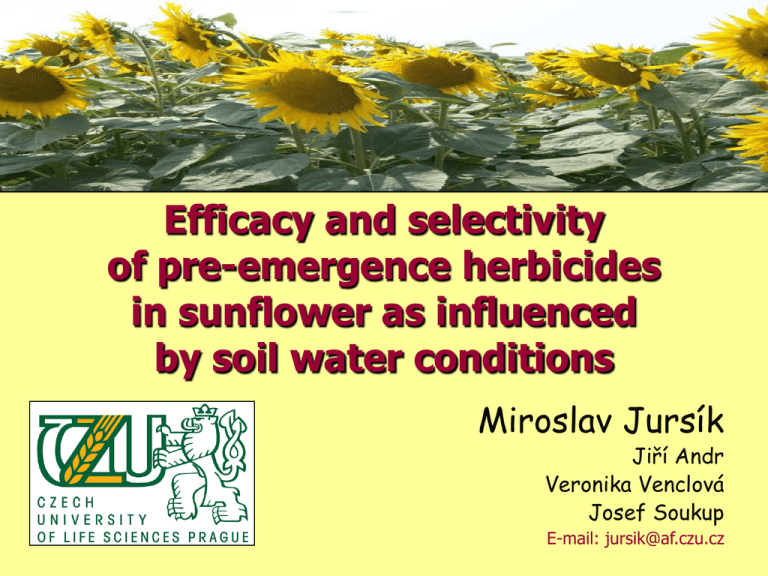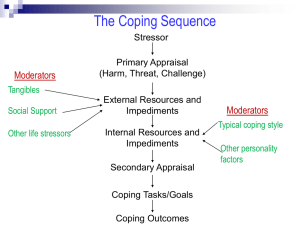15-JURSIK
advertisement

Efficacy and selectivity of pre-emergence herbicides in sunflower as influenced by soil water conditions Miroslav Jursík Jiří Andr Veronika Venclová Josef Soukup E-mail: jursik@af.czu.cz Typical sunflower weeds in the Czech Republic Echinochloa crus-galli Polygonum lapathifolium Chenopodium album Amaranthus retroflexus Locally occurring sunflower weeds in the Czech Republic Solanum nigrum Mercurialis annua Abutilon Theophrasti Datura stramonium Weed control in sunflower in Czech Republic 90 % of sunflower area is treated by pre-emergence soil herbicides sunflower is very sensitive to many herbicides – metabolic type of selectivity is usually low intensive precipitation after herbicide application (especially on sandy soil) may cause vertical movement of herbicide into the zone with germinating seeds of sunflower and damage them (phytotoxicity) Pre-emergence weed control in sunflower in the Czech Republic widely used tank-mix combinations of herbicides linuron prosulfocarb oxyfluorfen pendimethalin flurochloridone bifenox dicot weeds acetochlor + alachlor dimethenamid metolachlor grass weeds Material and methods Trial layout tested herbicides: Active ingredience Goal 2 E oxyfluorfen Herb. rate (l.ha-1) 1,00 Afalon 45 SC linuron 1,50 Racer 25 EC flurochloridone 3,00 Stomp 400 SC pendimethalin 4,00 Boxer prosulfocarb 5,00 Trophy acetochlor 2,50 Herbcide Half of each plot was irrigated by simulation of 30 mm precipitations (2-3 weeks after herbicide application) Material and methods experimental years: 2008 and 2009 soil characteristic: chernozem, clay content 46 %, soil pH (KCl) 7.5, sorption capacity of soil: 209 mmol(+), 87 ppm P, 203 ppm K, 197 ppm Mg, 8073 ppm Ca occurring weeds: Echinochloa crus-galli, Amaranthus retroflexus, Chenopodium album and Mercurialis annua Materials and methods Soil moisture conditions: dry condition – natural precipitation – 25 mm within 4 WAT wet condition – intensive natural precipitation (65 mm within 4 WAT) simulated rainfall – (natural precipitation 25 mm within 4 WAT + 30 mm irrigation) Efficacy of tested herbicides on Amaranthus retroflexus under different rainfall conditions dry condition simulated rainfall wet condition acetochlor prosulfocarb low efficacy in dry condition pendimethalin fluorochloridone low efficacy in dry condition linuron oxyfluorfen 0 10 20 30 40 50 60 70 80 90 100 efficacy (%) Efficacy of tested herbicides on Chenopodium album under different rainfall conditions dry condition simulated rainfall wet condition acetochlor prosulfocarb efficacy was not influenced by rainfall pendimethalin fluorochloridone linuron oxyfluorfen 0 10 20 30 40 50 60 70 80 90 100 efficacy (%) Efficacy of tested herbicides on Echinochloa crus-galli under different rainfall conditions dry condition simulated rainfall wet condition efficacy was not influenced by rainfall acetochlor prosulfocarb efficacy was not influenced by rainfall pendimethalin fluorochloridone linuron oxyfluorfen 0 10 20 30 40 50 60 70 80 90 100 efficacy (%) Efficacy of tested herbicides on Mercurialis annua in different dry condition dry condition simulated rainfall wet condition acetochlor prosulfocarb pendimethalin fluorochloridone linuron efficacy was not influenced by soil moisture oxyfluorfen 0 10 20 30 40 50 60 70 80 90 100 efficacy (%) Selectivity of tested herbicides to sunflower in different dry condition 4 week after application dry condition simulated rainfall wet condition acetochlor prosulfocarb no phytotoxicity in all tested rainfall conditions pendimethalin fluorochloridone linuron phytotoxicity influenced by size of rain drops oxyfluorfen 0 5 10 15 20 25 30 35 40 45 50 efficacy (%) Conclusions acetochlor excellent and long-term residual efficacy on E. crus-galli and A. retroflexus efficacy was not affected by rainfall Conclusions acetochlor Chenopodium album wet conditions Mercurialis annua dry conditions Conclusions acetochlor excellent and long-term residual efficacy to E. crus-galli and A. retroflexus efficacy was not affected by soil moisture slow metabolism by sunflower - risk if used on sandy soil sunflower injury is often hidden and cause a grow retardation Conclusions oxyfluorfen excellent efficacy on A. retroflexus and very good efficacy on M. annua – not very influenced by rainfall Conclusions oxyfluorfen E. crus-galli Chenopodium album wet conditions only in dry conditions Conclusions oxyfluorfen excellent efficacy on A. retroflexus and very good efficacy on M. annua – not very influenced by rainfall conditions short residual activity slow metabolism by sunflower – phytotoxicity was caused by rain drops which reflected from soil surface – necrosis and deformation of leaves Conclusions linuron good efficacy on all tested weeds, but only in wet conditions very low efficacy in dry conditions Conclusion linuron wet condition dry condition Conclusion linuron good efficacy on all tested weeds, but only in wet conditions low efficacy in dry conditions relative short residual activity (up to 2 months after application) – fast development of sunflower leaf coverage is necessary high selectivity to sunflower – possibility of use on sandy soils Conclusion flurochloridone Lower selectivity to sunflower – risk if used on sandy soils phytotoxicity symptom on sunflower is bleaching excellent efficacy on all tested weeds, but only in wet conditions reduced efficacy mainly on E. crus-galli and M. annua in dry conditions long-term residual activity Conclusion flurochloridone wet conditions dry conditions Conclusions prosulfocarb excellent efficacy on all tested weeds, but only in wet conditions in dry soil conditions, good efficacy was found only on A. retroflexus Conclusion prosulfocarb wet condition dry condition Conclusions prosulfocarb excellent efficacy on all tested weeds, but only in wet conditions in dry conditions good efficacy only on A. retroflexus was found relative short residual activity high selectivity to sunflower – possibility of use on sandy soils Conclusions pendimethalin excellent and long-term efficacy on C. album in all tested wet conditions for other assessed weeds - short residual activity and efficacy is partially influenced by soil water conditions Conclusion pendimethalin wet conditions dry conditions Conclusion pendimethalin excellent and long-term efficacy on C. album in all tested conditions for other tested weeds - short residual activity and efficacy is partially influenced by soil watter conditions breaking and lodging of stems may occurr as a result of callus creation on stem base Thank you for your attention








